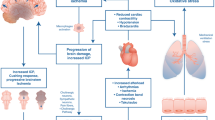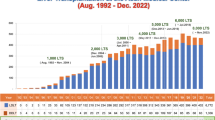Abstract
Organ transplantations have opened a new field in medicine and particularly in pediatrics. The kidney was the first organ to be regularly transplanted and there are now more than 2000 children who have received a kidney graft. Cadaver kidneys or living-related donor (LRD) kidneys can be used since an adult kidney may be grafted in a young child. Cadaver graft survival exceeds 85% at 1 year in recent single centre reports and patient survival is above 95%, the results being even better with LRD. Some complications may be observed in the long term, such as bone osteonecrosis, hypertension or infections. Rehabilitation is generally remarkable and growth which remained abnormal in 1/3 of cases under conventional treatment seems to improve markedly with cyclosporin. In the future, the development of kidney transplantation could lead hopefully to a drastic decrease in the number of children on dialysis. Liver transplantation is now performed in children with biliary atresia and metabolic diseases. There is no age limit for grafting a liver, the only problem being to find a pediatric cadaver donor of similar size. It is also possible to use an adult liver after hepatectomy. There were 170 liver grafts recorded in children in Europe in December 1986, and the long-term survival thanks to cyclosporin is exceeding 80% in some units. Thanks to cyclosporin, programs of cardiac transplantation for children are rapidly developing. The main indications are gross-congenital cardiac malformations or severe functional abnormality not compatible with life. Newborns have been grafted with success. The only problem is also to find a suitable pediatric donor. At the end of 1984, there were 88 cadaver transplantations reported in children, and this number is growing rapidly. Survival is estimated above 70% at 1 year. Indications for heart and lung transplantation are more numerous than for the heart alone, including severe cardiac malformations with abnormality of pulmonary circulation and a number of pulmonary diseases. A close similarity in the size of donor and recipient is mandatory. The immediate results are generally good, but the final outcome remains under evaluation. First investigated in animals, small intestine transplantation has been added recently to the list of possible organ transplantations in children. Indications are extensive intestinal resections, or malformations. The initial results are encouraging, but the long-term outcome remains under evaluation.
Similar content being viewed by others
References
Starzl TE, Marchioro TL, Porter KA, Faris TD, Carey TA (1966) The role of organ transplantation in pediatrics. Pediatr Clin North Am 13:381
Starzl TE, Iwatsuki S, Malatack JJ, Zitelli BJ, Gartner JC Jr, Hakals TR, Rosenthal JT, Schaw BW Jr (1982) Liver and kidney transplantation in children receiving Ciclosporin A and steroids. J Pediatr 100:681
European Dialysis and Transplant Association Registry (1986) Demography of dialysis and transplantation in children in Europe 1984. Nephrol Dial Transplant 1:9
Tejani A (1986) Therapy of end stage renal disease in children, Kidney Int 29 suppl 19:51
Fine RN (1985) For children renal transplantation is the only realistic choice. Kidney Int 28 [Suppl. 17]:S15
European Dialysis and Transplant Association Registry (1986) Combined report on regular dialysis and transplantation in Europe 1985. Hospal, Basel, p 65
Avner ED, Harmon WE, Grupe WE, Ingelfinger JR, Eraklis AJ, Levey RH (1981) Mortality of chronic hemodialysis and renal transplantation in pediatric end stage renal disease. Pediatrics 67:412
Broyer M, Gagnadoux MF, Guest G, Beurton D, Niaudet P, Habib R, Busson M (1986) Kidney transplantation in children. Results of 383 grafts performed at Enfants-Malades Hospital from 1973 to 1984. Adv Nephrol 16:307
Broyer M, Guest G (1987) La croissance après transplantation rénale chez l'enfant. Journées Parisiennes de Pédiatrie. Flammarion Medécine Sciences, Paris
Offner G, Hoyer PF, Brodehl J, Pilchmayr R (1987) Cyclosporin A in paediatric kidney transplantation. Pediatr Nephrol 1:125
Ettenger RB, Korsch BM, Main ME, Fine RN (1979) Renal rehabilitation of children and adolescents with end-stage renal disease. In: Chyatte SB (ed) Rehabilitation in chronic renal failure. Williams and Wilkins, Baltimore, p 115
Mowat AP (1987) Liver disorders in children, the indications for liver replacement in parenchymal and metabolic disease. Transplant Proc 19:3236
De Hemptine B, De Ville de Goyet J, Kestens PJ, Otte JB (1987) Volume reduction of the liver graft before orthotopic transplantation. Transplant Proc 19:3317
Bismuth H, Ericzon BG, Rolles K, Castaing D, Otte JB, Ringe B, Sloof M (1987) Hepatic transplantation in Europe, first report of the European liver transplant registry. Lancet 2:674
Bailey LL, Nehlsen-Cannarelly SL, Doroshow RW, Jacobson JG, Martin RD, Allard MW, Hyde MR, Dangbui RH, Petry EL (1986) Cardiac allotransplantation in newborns as therapy for hypoplastic left heart syndrome. N Engl J Med 315:949
Wiles HB, Bricker JT, Cooley DA, Nihill MR, Frazier OH, Waldenberger F, McNamara DG (1986) Repeated endomyocardial biopsy without complication in an infant after heart transplantation. J Thorac Cardiovasc Surg 91:637
Fricker J (1985) Experience with heart transplantation in children. In: Doyle EF, Engle MA, Gersony WM, Rashkind W, Talner NS (eds) Pediatriccardiology. Springer, Berlin Heidelberg New York, p 616
Stauffer UG (1975) Transplantation of the small intestine. Prog Ped Surg 8:1
Ricour C, Revillon Y, Pletynex M, Lauffenburger A, Jehannin B, Ghnassia D, Duval C, Gnassia JC, Jos J, Fontained JL (1981) Conservation hyperthermique et autotransplantation du grêle chez le porcelet. Gastroenterol Clin Biol 5:977
Ricour C, Revillon Y, Arnaud-Battandier F, Gnassia D, Weyne P, Lauffenburger A, Jos J, Fontaine JL, Gallix P, Vaiman M (1983) Successful small bowel allograft in piglets using cyclosporine. Transplant Proc 15:3019
Author information
Authors and Affiliations
Rights and permissions
About this article
Cite this article
Broyer, M., Otte, J.B., Kachaner, J. et al. Organ transplantation in children. Intensive Care Med 15 (Suppl 1), S76–S79 (1989). https://doi.org/10.1007/BF00260895
Issue Date:
DOI: https://doi.org/10.1007/BF00260895




